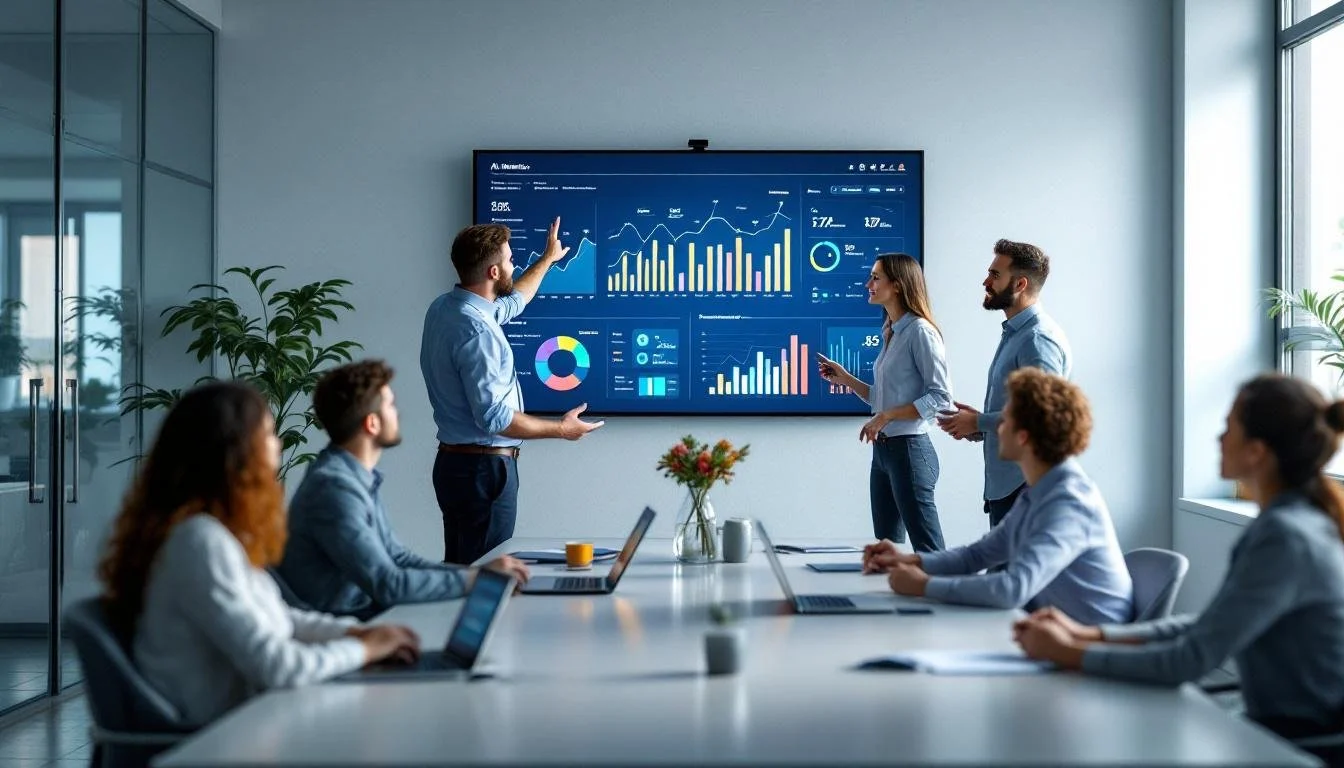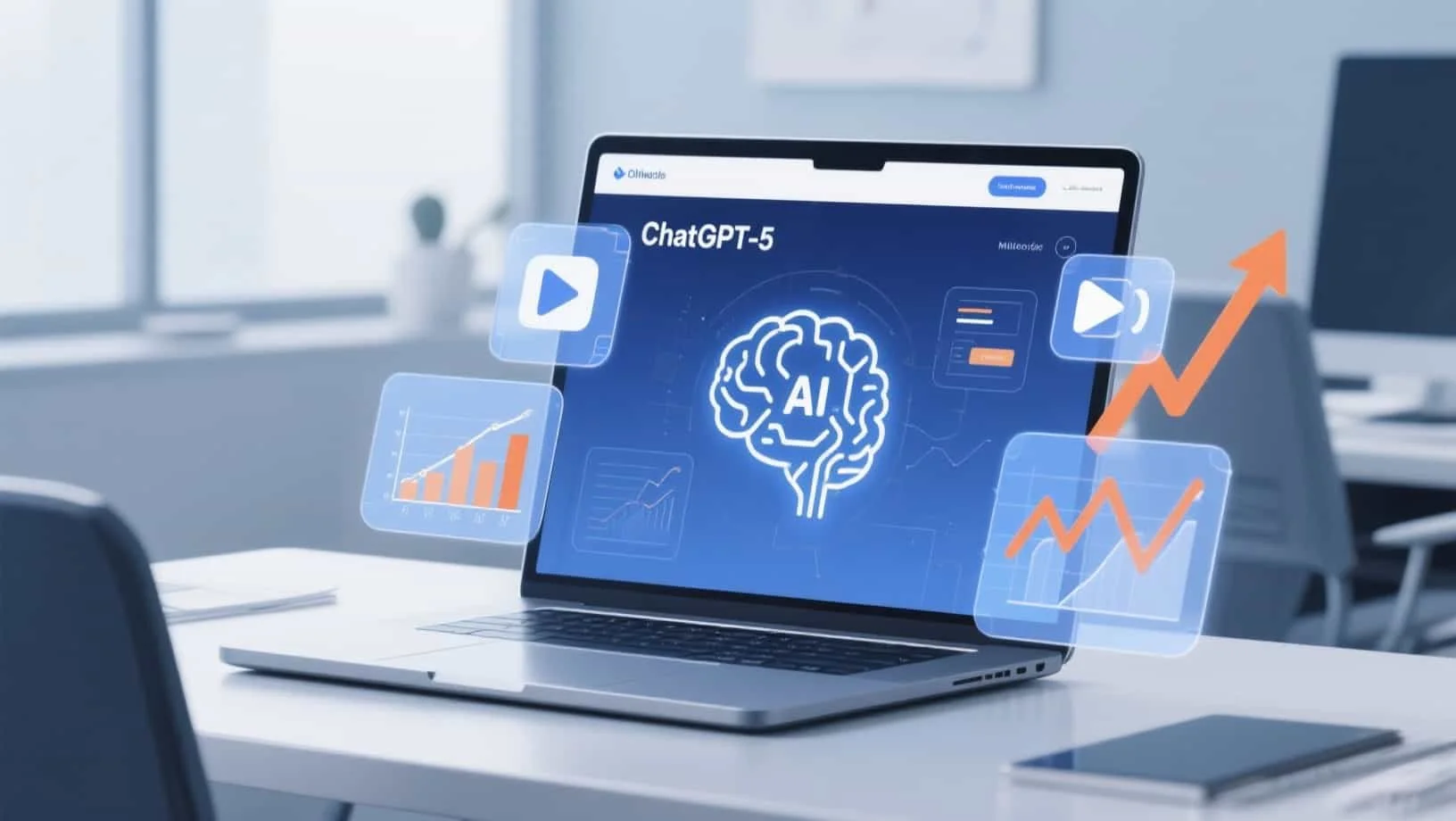How AI marketing strategies will grow your business in 2025
The world of marketing is changing rapidly. By 2025, artificial intelligence (AI) will no longer be an option, but a necessary driving force behind every successful marketing strategy. Companies that invest in AI today are building an unprecedented advantage over their competitors. In this ultimate guide, you'll discover how AI can transform your marketing, what specific strategies and tools you need, and how to avoid the most common pitfalls. Plus, you'll get practical examples and a concrete step-by-step plan to get started right away. Ready to accelerate your marketing?
- 86% efficiency gain: Marketers report that AI makes their work more efficient, 30% faster revenue growth
- 5 game-changing strategies: Hyper-personalization, lead scoring, real-time ad optimization, predictive retention, dynamic pricing
- Content creation revolutionized: ChatGPT, Jasper, DALL·E create content within minutes, scalable hyper-personalization
- Predictive analytics mainstream: Predict customer behavior, churn, optimal send times with Pecan.ai, Salesforce Einstein
- 5-step implementation: Analyze data, choose use case, select tools, test small, evaluate and scale up
- Conversational AI 24/7: Chatbots qualify leads, give recommendations, deepen customer relationships automatically
1. Why AI is indispensable in marketing in 2025
The numbers don't lie
Over the past five years, the use of AI in marketing has more than doubled. Research from Salesforce shows that 86% of marketing professionals report that AI makes their work more efficient. Moreover, companies that effectively use AI achieve an average revenue growth rate 30% faster than those that lag behind. These figures underscore that AI is no longer just a "nice to have," but a fundamental building block for modern marketing strategies.
Impact on customer behavior
Consumers are becoming increasingly demanding. They expect personalized experiences, immediate responses, and a seamless customer journey. AI enables marketers to analyze behavioral patterns in real-time and display personalized content or offers at precisely the right moment. Without AI, it is becoming increasingly difficult to meet these high expectations.
Automation and data analysis
AI technologies like machine learning and natural language processing help marketers process vast amounts of data and extract meaningful insights. Where human analysis falls short in recognizing complex patterns, AI excels. This makes it possible to act not only faster, but also much smarter.
In conclusion: AI is no longer a trend, but a necessity for successful marketing in 2025.
“Marketers have so far only scratched the surface of AI, mainly for content generation. In 2025, we expect marketers to make the leap to AI for creative ideation, data-driven decision-making, and strategic brainstorming sessions”
Source: HubSpot - The 2025 State of Marketing Report
2. AI applications that are already transforming your marketing
Content Creation
AI is transforming content creation. Tools like ChatGPT and Jasper AI can generate compelling blog posts, product descriptions, and social media posts in minutes. Visuals are created with platforms like DALL·E and Midjourney, which deliver unique images based on text prompts. This not only accelerates content production but also enables hyper-personalization at scale.
Email marketing automation
Personalization is key to effective email marketing, and AI takes this to the next level. Platforms like Mailchimp and Rasa.io use AI to automatically create segments, place dynamic content in emails, and optimize send times based on the behavior of individual recipients. This significantly increases open rates, click-through rates, and conversion rates.
Predictive analytics
Predictive analytics is the ability of AI to forecast future customer behavior based on historical data. Using tools like Pecan.ai and Salesforce Einstein, you can predict which customers are likely to convert, when they will repurchase, or when they are at risk of churning. This allows you to target your marketing efforts much more effectively.
Conversational AI
Conversational AI, such as chatbots and virtual assistants, enables you to offer personalized interactions 24/7. Advanced bots can not only answer simple questions, but also qualify leads, provide personalized product recommendations, and deepen customer relationships.
“Marketers will need to learn how to integrate AI into their work. The space is moving so fast and we need to experiment with everything - from the more established use cases to newer areas such as creativity development”
Source: HubSpot - State of Marketing Trends Report
3. 5 AI-powered strategies you need to implement in 2025
1. Hyper-personalization at scale
AI enables you to use not only demographic data but also behavioral and contextual data to create hyper-personalized experiences. Think of dynamic websites that adapt to individual visitors, or emails that are unique to each recipient.
2. Automated lead scoring and nurturing
By analyzing visitor behavior data and interactions with content, AI can automatically assign lead scores and determine when leads are ready for sales follow-up. This boosts your sales team's productivity and improves conversion rates.
3. Real-time ad optimization
AI can analyze millions of data points to optimize your ad performance in real-time. This means that bids are automatically adjusted, target audiences are refined, and creatives are dynamically adapted based on current results.
4. Predictive Customer Retention
AI detects early signs of customer dissatisfaction or potential churn. This allows you to proactively implement personalized incentives or loyalty programs to reduce churn.
5. Dynamic pricing and offers
With AI, you can dynamically adjust prices and offers based on demand, competition, and customer behavior. This maximizes your revenue and allows you to respond optimally to market fluctuations.
“The key to successful marketing lies in building authenticity and trust. Personality-driven content, delivered via creators and channels that resonate with target audiences, is integral to achieving that”
Source: HubSpot - State of Marketing Trends Report
4. Real-world examples: How successful companies are using AI
E-commerce: Personalized recommendations
A shoe brand analyzes customer browsing and purchasing behavior and displays personalized product recommendations. Result: an increase of 25% in the average order value and a rise in customer satisfaction.
B2B: Lead scoring and sales optimization
A SaaS company implements AI-powered lead scoring. As a result, only the most promising leads are passed on to sales, leading to a 30% faster sales cycle and a 20% higher win rate.
Retail: Contextual email campaigns
An international clothing chain uses AI to combine weather forecasts with customer data. When it rains, customers receive emails with promotions for raincoats, while sunny weather puts beachwear in the spotlight. These contextual campaigns double the click-through rates.
“91% of marketing leaders say that employees/teams in their organization use AI to help them in their work. 65% of marketing leaders expect to increase their investment in AI and automation tools in 2025”
Source: HubSpot - The State of AI Report 2025
5. The best AI tools for marketers in 2025
Content creation: Jasper AI, Copy.ai, Writesonic
Data Analysis: Pecan AI, Tableau AI, Google BigQuery ML
CRM and Automation: Salesforce Einstein, HubSpot AI, Zoho CRM Plus
Conversational marketing: Drift, Intercom, Ada
Ad Optimization: Albert.ai, Adobe Sensei, Meta Advantage+ Suite
Each tool offers unique benefits depending on your business objectives and existing tech stack.
Want to discover more applications? Then also read: The 7 indispensable AI tools that every marketer should know in 2025.
“65% of senior executives identify AI and predictive analytics as primary growth drivers for 2025. These technologies can create next-level personalization - faster, at scale, and more efficiently than ever before”
Source: Adobe - 2025 AI and Digital Trends Report
6. Step-by-step plan: How to start using AI in your marketing today
Step 1: Analyze your current data
Map out what data you collect, where it is stored, and how clean it is. Without high-quality data, AI has little value.
Step 2: Choose a specific use case
Begin with a well-defined application, such as AI-driven email segmentation or ad optimization. This focus ensures rapid results and learning.
Step 3: Select the right tools
Research which AI tools best fit your use case, budget, and technical infrastructure. Pay attention to integration options and user-friendliness.
Step 4: Test on a small scale
Conduct a pilot project with clear KPIs and hypotheses. Measure not only the results, but also process factors such as ease of use and reliability.
Step 5: Evaluate and scale up
Critically analyze the results. What worked well? What could be improved? Use these insights to gradually expand your AI strategy.
Want to get the most out of AI? Check out our Masterclass ChatGPT 2025: the ultimate guide for advanced marketers and entrepreneurs.
“AI is a once-in-a-lifetime technology. Over time, AI will be the biggest technological shift we will see in our lives. It's bigger than the shift from desktop computing to mobile, and it may be bigger than the internet itself”
Source: Nasdaq - Google CEO Sundar Pichai on AI Revolution
7. Common mistakes and how to avoid them
Trying to do too much at once: Focus on one application at a time to avoid chaos and wasted resources.
Neglecting Data Quality: Poor data leads to incorrect insights and ineffective campaigns.
AI without human oversight: Leverage AI for support, but maintain human control over strategy, ethics, and creativity.
Avoid common mistakes in AI projects! Also read: Prompt engineering for advanced users: get more out of ChatGPT.
8. Future vision: How AI will further transform the marketing world in the next 5 years
AI and ethics
Consumers are increasingly aware of how their data is used. Transparency and ethical AI applications will provide a competitive advantage. Companies that are not transparent risk reputational damage and legal penalties.
AI and creative processes
Instead of threatening creative jobs, AI will act as a co-creation partner. Ideas can be explored and developed faster, but human creativity remains essential for genuine innovation and emotional connection.
The new role of marketers
The marketer of 2030 will no longer be an implementer, but a strategist who trains AI models, interprets data, and uses human creativity to build impactful campaigns.
Curious about the future of AI in marketing? Read: The rise of AI in online marketing: a revolutionary change.
By 2025, your use of AI will determine the success of your marketing. Companies that cleverly combine AI with human creativity and ethical leadership will not only grow but also gain a competitive edge that is difficult to overcome.

🚀 Get more results from AI, online marketing, and e-commerce
Do you have ideas you want to realize faster? Do you want more leads, smarter marketing, or better use of AI in your company? We actively think along with you. Discover what AI can do for your growth, online marketing or e-commerce can mean for you.
💬 Prefer to spar right away? Schedule a video call without obligation with Frederiek.
👉 Or ask your question via the contact form, email frederiek@clickforest.com or call +32 473 84 66 27.
📄 Want to get inspired? Download the free whitepaper 'AI for SMEs in 2025' with concrete tips & insights.
Together we discover how you can get more out of your marketing, technology and AI today.
Frequently asked questions about AI-driven marketing strategies
-
AI-driven marketing involves using artificial intelligence to automate, optimize, and personalize marketing activities. This includes analyzing customer data to create targeted campaigns, using chatbots to answer customer questions 24/7, and employing predictive analytics to forecast future customer behavior. AI enables businesses to operate more efficiently, improve customer experience, and achieve better results with fewer resources.
-
The choice of AI tools depends on your specific needs. For content creation, Jasper AI and Copy.ai are leading the way. For CRM automation and lead scoring, Salesforce Einstein and HubSpot AI are excellent choices. For ad optimization, Albert.ai and Adobe Sensei perform exceptionally well. Always choose tools that integrate well with your existing systems and are scalable for the future.
-
The speed at which you see results depends on the use case, the quality of your data, and your implementation strategy. For simple applications like personalized emails, you can see an increase in engagement and conversions within 1 to 3 months. More complex applications, such as predictive analytics, require more preparation time but deliver substantial benefits within 6 to 12 months.
-
Absolutely. Thanks to the rise of user-friendly and affordable AI tools, it's now possible for small businesses to implement AI. Think of automated social media posts, personalized newsletters, or smart chatbots. Start small, choose a clear focus, and build from there.
-
The main challenges are:
Data availability and quality.
Integration with existing systems.
Ethical considerations regarding privacy and transparency.
Finding the right balance between automation and human creativity.
Internal resistance to change.
A well-thought-out strategy and effective change management help overcome these obstacles.
-
Transparency is key. Clearly inform customers about the use of AI and give them control over their own data. Ensure that your algorithms do not contain biases that could lead to unfair treatment of certain groups. Comply with existing laws and regulations, such as the GDPR in Europe, and incorporate ethical guidelines into your AI strategy.
-
Absolutely. AI can automate and accelerate many tasks, but human marketers remain essential for strategy, creativity, empathy, and ethical awareness. The role of marketers is shifting from execution to advising and coordinating, using AI as an amplifier.
-
The costs vary greatly depending on the tools and scope. Basic AI tools like ChatGPT Plus cost €20/month, while professional platforms like HubSpot AI start from €500/month. For SMEs, a budget of €200-1000/month is realistic for a solid AI marketing setup.
-
For effective AI marketing, you need customer demographics, behavioral data (website visits, email interactions), purchase history, and engagement metrics. The more qualitative data you have, the better AI can personalize and predict.
-
AI rarely completely replaces existing tools, but often integrates with them or improves their functionality. Many modern marketing platforms already have AI functions built in. It's more about using them smarter than replacing them.
Sources and references
AI marketing trends and research:
WordStream: "5 AI marketing trends to watch in 2025 (+how they'll impact you)" - https://www.wordstream.com/blog/ai-marketing-trends-2025
Adobe: "Adobe 2025 AI and digital trends report" - https://business.adobe.com/resources/digital-trends-report.html
HubSpot: "2025 AI trends for marketers" - https://offers.hubspot.com/ai-marketing
Improvado: "AI marketing trends: what you need to know in April 2025" - https://improvado.io/blog/ai-marketing-trends
API4AI: "10 AI marketing trends that will dominate 2025" - https://medium.com/@API4AI/10-ai-marketing-trends-to-watch-in-2025-78a3372da657
Salesforce research and statistics:
Salesforce: "Top generative AI statistics for 2025" - https://www.salesforce.com/news/stories/generative-ai-statistics/
Salesforce: "New Salesforce report: AI is marketers' top priority - and biggest headache" - https://www.salesforce.com/news/stories/marketing-trends-ai-data/
Salesforce: "19 marketing trends shaping 2025 [backed by new data]" - https://www.salesforce.com/au/marketing/marketing-trends/
AI tools for content creation:
Jasper AI: "The 2025 state of AI in marketing: trends and insights from 500+ marketers" - https://www.jasper.ai/blog/2025-ai-marketing-trends-insights-report
CoSchedule: "State of AI in marketing report 2025 | AI marketing statistics" - https://coschedule.com/ai-marketing-statistics
Pecan AI: "Predictive analytics for digital marketing" - https://www.pecan.ai/blog/predictive-analytics-for-digital-marketing/
AI platforms and technology:
Adobe: "Adobe Sensei AI | Adobe Experience Cloud" - https://business.adobe.com/products/sensei/adobe-sensei.html
Gartner: "Marketing AI: the future of smart marketing" - https://www.gartner.com/en/marketing/topics/ai-in-marketing
ContentGrip: "The future of marketing: AI transformations by 2025" - https://www.contentgrip.com/future-ai-marketing/











